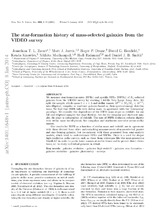| dc.contributor.author | Zwart, Jonathan T.L. | |
| dc.contributor.author | Jarvis, Matt | |
| dc.contributor.author | Deane, Roger P. | |
| dc.contributor.author | Bonfield, David G. | |
| dc.contributor.author | Knowles, Kenda | |
| dc.contributor.author | Madhanpall, Nikhita | |
| dc.contributor.author | Rahmani, Hadi | |
| dc.contributor.author | Smith, Daniel J.B. | |
| dc.date.accessioned | 2016-10-12T15:07:47Z | |
| dc.date.available | 2016-10-12T15:07:47Z | |
| dc.date.issued | 2014 | |
| dc.identifier.citation | Zwart, J.T.L. et al. (2014). The star-formation history of mass-selected galaxies from the VIDEO survey. Monthly Notices of the Royal Astronomical Society, 439(2): 1459-1471 | |
| dc.identifier.issn | 0035-8711 | |
| dc.identifier.uri | http://hdl.handle.net/10566/2446 | |
| dc.identifier.uri | http://dx.doi.org/10.1093/mnras/stu053 | |
| dc.description.abstract | We measure star formation rates (SFRs) and specific SFRs (SSFRs) of Ks-selected galaxies from the VISTA Deep Extragalactic Observations survey by stacking 1.4 GHz Very Large Array data. We split the sample, which spans 0 < z < 3 and stellar masses 108.0 < M*/M < 1011.5, into elliptical, irregular or starburst galaxies based on their spectral energy distributions. We find that SSFR falls with stellar mass, in agreement with the 'downsizing' paradigm. We consider the dependence of the SSFR - mass slope on redshift: for our full and elliptical samples the slope flattens, but for the irregular and starburst samples the slope is independent of redshift. The rate of SSFR evolution reduces slightly with stellar mass for ellipticals, but irregulars and starbursts co-evolve across stellar masses. Our results for SSFR as a function of stellar mass and redshift are in agreement with those derived from other radio-stacking measurements of mass-selected passive and star-forming galaxies, but inconsistent with those generated from semi-analytic models, which tend to underestimate SFRs and SSFRs. There is a need for deeper high-resolution radio surveys such as those from telescopes like the next-generation MeerKAT in order to probe lower masses at earlier times and to permit direct detections, i.e. to study individual galaxies in detail. | en_US |
| dc.language.iso | en | en_US |
| dc.publisher | Oxford University Press | |
| dc.rights | This is the author version of the article available online at: http://dx.doi.org/10.1093/mnras/stu053 | |
| dc.source.uri | http://dx.doi.org/10.1093/mnras/stu053 | |
| dc.subject | Galaxies | en_US |
| dc.subject | Star formation | en_US |
| dc.subject | Astronomy | en_US |
| dc.subject | Redshift | en_US |
| dc.subject | VISTA Deep Extragalactic Observations | en_US |
| dc.title | The star-formation history of mass-selected galaxies from the VIDEO survey | en_US |
| dc.type | Article | en_US |
| dc.privacy.showsubmitter | FALSE | |
| dc.status.ispeerreviewed | TRUE | |
| dc.description.accreditation | ISI | en_US |

